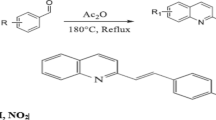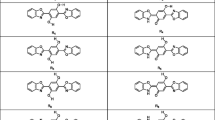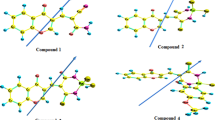Abstract
Dapsone has been receiving growing interest due to it use as a new class of corrosion inhibitors, forming copolymers with aniline, pyrrole, diphenylamine and 4-aminodiphenylamine. The present work focuses on characterizing the theoretical and experimental electronic spectra of the neutral, monoprotonated and diprotonated dapsone. The theoretical electronic spectrum was obtained through the excited state characterization via time-dependent DFT theory. NBO analysis was carried out to identify the molecular orbitals involved in the detected experimental UV bands. The detected absorption wavelength values for the neutral dapsone were 292 and 258 nm (experiment), and 286.9 and 251.7 nm (theoretical). Concerning the protonated dapsone species, it was observed that the absorbance values were strongly dependent on pH, especially at pH between 1.0 and 4.0. As the pH of the solution decreases, the experimental band at 292 nm slowly decreases and shifts to 290 nm, while the absorption at 258 nm decreases until it disappears, and a new absorption band arises at 240 nm. While, when the basicity increases, the absorption spectra of dapsone do not change, but a regular red shift is noticed, and it is continued even up to pH 14.0. The red-shifted spectra may be due to the formation of a monoanion and/or dianion, but the isosbestic points were not constant.











Similar content being viewed by others
References
Grunwald MH, Amichai B (1996) Dapsone—the treatment of infectious and inflammatory diseases in dermatology. Int J Antimicrob Agents 7:187–192
Barnetson RS, Pearson JM, Rees RJ (1976) Evidence for prevention of borderline leprosy reactions by dapsone. Lancet 2:1171–1172. https://doi.org/10.1016/S0140-6736(76)91684-6
Dhople AM (2002) In vivo activity of epiroprim, a dihydrofolate reductase inhibitor, singly and in combination with dapsone, against Mycobacterium leprae. Int J Antimicrob Agents 19:71–74. https://doi.org/10.1016/S0924-8579(01)00470-8
Walling HW, Sontheimer RD (2009) Cutaneous lupus erythematosus: issues in diagnosis and treatment. Am J Clin Dermatol 10:365–381. https://doi.org/10.2165/11310780-000000000-00000
Ti TY, Jacob E, Wee YJ (1987) The effect of dapsone-pyrimethamine on immunoglobulin concentrations in malaria chemoprophylaxis. Trans R Soc Trop Med Hyg 81:245–246. https://doi.org/10.1016/0035-9203(87)90230-6
Yeo AET, Edstein MD, Rieckmann KH (1997) Antimalarial activity of the triple combination of proguanil, atovaquone and dapsone. Acta Trop 67:207–214. https://doi.org/10.1016/S0001-706X(97)00060-0
Mofenson LM, Brady MT, Danner SP, et al (2009) Guidelines for the prevention and treatment of opportunistic infections among HIV-Exposed and HIV-Infected children
Siberry GK, Abzug MJ, Nachman S et al (2013) Guidelines for the prevention and treatment of opportunistic infections in HIV-exposed and HIV-infected children. Pediatr Infect Dis J. https://doi.org/10.1097/01.inf.0000437856.09540.11
Moura SL, Santos Júnior JR, Machado FBC et al (2015) Conductive organic polymers: an electrochemical route for the polymerization of dapsone. J Electroanal Chem 757:230–234. https://doi.org/10.1016/j.jelechem.2015.09.037
Singh A, Kumar Singh A, Quraishi MA (2010) Dapsone: a novel corrosion inhibitor for mild steel in acid media. Open Electrochem 2(1):43–51
Singh A, Avyaya JN, Ebenso EE, Quraishi MA (2013) Schiff’s base derived from the pharmaceutical drug Dapsone (DS) as a new and effective corrosion inhibitor for mild steel in hydrochloric acid. Res Chem Intermed 39:537–551. https://doi.org/10.1007/s11164-012-0577-y
Chakravarthy MP, Mohana KN, Kumar CBP, Badiea AM (2015) Corrosion inhibition behaviour and adsorption characteristics of dapsone derivatives on mild steel in acid medium. Am Chem Sci 8:1–16
Manisankar P, Vedhi C, Selvanathan G, Gurumallesh Prabu H (2006) Copolymerization of aniline and 4,4′-diaminodiphenyl sulphone and characterization of formed nano size copolymer. Electrochim Acta 52:831–838. https://doi.org/10.1016/j.electacta.2006.06.017
Sharifirad M, Kiani F, Koohyar F (2013) Electrochemical characterization of the nano Py/DDS/SiO2 film on a copper electrode. Mater Technol 47:341–347
Manisankar P, Ilangeswaran D (2010) Electrochemical synthesis and spectroelectrochemical behavior of poly(diphenylamine-co-4,4′-diaminodiphenyl sulfone). Electrochim Acta 55:6546–6552. https://doi.org/10.1016/j.electacta.2010.06.023
Ilangeswaran D, Manisankar P (2013) Electrochemical synthesis, characterization and electrochromic behavior of poly(4-aminodiphenylamine-co-4,4′-diaminodiphenyl sulfone). Electrochim Acta 87:895–904. https://doi.org/10.1016/j.electacta.2012.09.040
Muthu S, Uma Maheswari J (2012) Quantum mechanical study and spectroscopic (FT-IR, FT-Raman, 13C, 1H, UV) study, first order hyperpolarizability, NBO analysis, HOMO and LUMO analysis of 4-[(4-aminobenzene) sulfonyl] aniline by ab initio HF and density functional method. Spectrochim Acta Part A Mol Biomol Spectrosc 92:154–163. https://doi.org/10.1016/j.saa.2012.02.056
Bhattacharya P, Sahoo D, Chakravorti S (2012) Revisit of 4,4′-diaminodiphenyl sulfone photophysics in different solvents. Ind Eng Chem Res 51:2505–2514. https://doi.org/10.1021/ie201113b
Hariharan PC, Pople JA (1973) The influence of polarization functions on molecular orbital hydrogenation energies. Theor Chim Acta 28:213–222. https://doi.org/10.1007/BF00533485
Clark T, Chandrasekhar J, Spitznagel GW, Schleyer PVR (1983) Efficient diffuse function-augmented basis sets for anion calculations. III. The 3 − 21 + G basis set for first-row elements, Li–F. J Comput Chem 4:294–301. https://doi.org/10.1002/jcc.540040303
Francl MM, Pietro WJ, Hehre WJ et al (1982) Self-consistent molecular orbital methods. XXIII. A polarization-type basis set for second-row elements. J Chem Phys 77:3654–3665. https://doi.org/10.1063/1.444267
Spitznagel GW, Clark T, von Ragué Schleyer P, Hehre WJ (1987) An evaluation of the performance of diffuse function-augmented basis sets for second row elements, Na–Cl. J Comput Chem 8:1109–1116. https://doi.org/10.1002/jcc.540080807
Diaz-Fleming G, Célis F, Fredes C et al (2010) Surface-enhanced Raman scattering and density functional theory studies of bis(4-aminophenyl)sulfone. J Raman Spectrosc 41:160–166. https://doi.org/10.1002/jrs.2409
Forner W, Badawi HM (2011) A DFT analysis of the molecular structures and vibrational spectra of diphenylsulfone and 4,4′-sulfonyldianiline (Dapsone). Zeitschrift fur Naturforsch B 66(1):69–76
Mendes APS, Schalcher TR, Barros TG et al (2011) A geometric and electronic study of dapsone. J Comput Theor Nanosci 8:1–4. https://doi.org/10.1166/jctn.2011.1832
Borges RS, Vale JKL, Schalcher TR et al (2013) A theoretical study of the dapsone derivatives on methemoglobin. J Comput Theor Nanosci 10:2029–2033. https://doi.org/10.1166/jctn.2013.3165
Ildiz GO, Akyuz S (2012) Conformational analysis and vibrational spectroscopic studies on dapsone. Opt Spectrosc 113:495–504. https://doi.org/10.1134/s0030400x12110033
Bhattacharya P, Chakravorti S (2013) Spectral features of 4,4-diaminodiphenyl sulfone in anionic and cationic inverted micelles. Chem Phys Lett 571:71–76. https://doi.org/10.1016/j.cplett.2013.04.003
Rajendiran N, Swaminathan M (1995) Solvatochromism and prototropism of diaminodiphenyl sulphones and 2-aminodiphenyl sulphone: a comparative study by electronic spectra. J Photochem Photobiol A Chem 90:109–116. https://doi.org/10.1016/1010-6030(95)04078-T
Gill PMW, Johnson BG, Pople JA, Frisch MJ (1992) The performance of the Becke–Lee–Yang–Parr (B-LYP) density functional theory with various basis sets. Chem Phys Lett 197:499–505. https://doi.org/10.1016/0009-2614(92)85807-M
Zhao Y, Truhlar DG (2008) The M06 suite of density functionals for main group thermochemistry, thermochemical kinetics, noncovalent interactions, excited states, and transition elements: two new functionals and systematic testing of four M06-class functionals and 12 other function. Theor Chem Acc 120:215–241. https://doi.org/10.1007/s00214-007-0310-x
Gordon MS, Binkley JS, Pople JA et al (1982) Self-consistent molecular-orbital methods. 22. Small split-valence basis sets for second-row elements. J Am Chem Soc 104:2797–2803. https://doi.org/10.1021/ja00374a017
Hehre WJ, Ditchfield R, Pople JA (1972) Self—consistent molecular orbital methods. XII. Further extensions of Gaussian—type basis sets for use in molecular orbital studies of organic molecules. J Chem Phys 56:2257–2261. https://doi.org/10.1063/1.1677527
Krishnan R, Binkley JS, Seeger R, Pople JA (1980) Self-consistent molecular orbital methods. XX. A basis set for correlated wave functions. J Chem Phys 72:650–654. https://doi.org/10.1063/1.438955
McLean AD, Chandler GS (1980) Contracted Gaussian basis sets for molecular calculations. I. Second row atoms, Z = 11–18. J Chem Phys 72:5639–5648. https://doi.org/10.1063/1.438980
Dickinson C, Stewart JM, Ammon HL (1970) The X-ray crystal structure of the antimalarial and antileprotic drug, 4,4′-diaminodiphenyl sulphone. J Chem Soc D Chem Commun 15:920–921
Caricato M (2012) Absorption and emission spectra of solvated molecules with the EOM–CCSD–PCM method. J Chem Theory Comput 8:4494–4502. https://doi.org/10.1021/ct3006997
Lipparini F, Scalmani G, Mennucci B et al (2010) A variational formulation of the polarizable continuum model. J Chem Phys 133:14106. https://doi.org/10.1063/1.3454683
Barone V, Cossi M, Tomasi J (1997) A new definition of cavities for the computation of solvation free energies by the polarizable continuum model. J Chem Phys 107:3210–3221. https://doi.org/10.1063/1.474671
Cancès E, Mennucci B, Tomasi J (1997) A new integral equation formalism for the polarizable continuum model: theoretical background and applications to isotropic and anisotropic dielectrics. J Chem Phys 107:3032–3041. https://doi.org/10.1063/1.474659
Mennucci B, Tomasi J (1997) Continuum solvation models: a new approach to the problem of solute’s charge distribution and cavity boundaries. J Chem Phys 106:5151–5158. https://doi.org/10.1063/1.473558
Mennucci B, Cancès E, Tomasi J (1997) Evaluation of solvent effects in isotropic and anisotropic dielectrics and in ionic solutions with a unified integral equation method: theoretical bases, computational implementation, and numerical applications. J Phys Chem B 101:10506–10517. https://doi.org/10.1021/jp971959k
Barone V, Cossi M (1998) Quantum calculation of molecular energies and energy gradients in solution by a conductor solvent model. J Phys Chem A 102:1995–2001. https://doi.org/10.1021/jp9716997
Cossi M, Barone V, Mennucci B, Tomasi J (1998) Ab initio study of ionic solutions by a polarizable continuum dielectric model. Chem Phys Lett 286:253–260. https://doi.org/10.1016/S0009-2614(98)00106-7
Tomasi J, Mennucci B, Cammi R (2005) Quantum Mechanical Continuum Solvation Models. Chem Rev 105:2999–3094. https://doi.org/10.1021/cr9904009
Bauernschmitt R, Ahlrichs R (1996) Treatment of electronic excitations within the adiabatic approximation of time dependent density functional theory. Chem Phys Lett 256:454–464. https://doi.org/10.1016/0009-2614(96)00440-X
Casida ME, Jamorski C, Casida KC, Salahub DR (1998) Molecular excitation energies to high-lying bound states from time-dependent density-functional response theory: characterization and correction of the time-dependent local density approximation ionization threshold. J Chem Phys 108:4439–4449. https://doi.org/10.1063/1.475855
Stratmann RE, Scuseria GE, Frisch MJ (1998) An efficient implementation of time-dependent density-functional theory for the calculation of excitation energies of large molecules. J Chem Phys 109:8218
Van Caillie C, Amos RD (2000) Geometric derivatives of density functional theory excitation energies using gradient-corrected functionals. Chem Phys Lett 317:159–164. https://doi.org/10.1016/S0009-2614(99)01346-9
Furche F, Ahlrichs R (2002) Adiabatic time-dependent density functional methods for excited state properties. J Chem Phys 117:7433–7447. https://doi.org/10.1063/1.1508368
Scalmani G, Frisch MJ, Mennucci B et al (2006) Geometries and properties of excited states in the gas phase and in solution: theory and application of a time-dependent density functional theory polarizable continuum model. J Chem Phys 124:94107. https://doi.org/10.1063/1.2173258
Frisch MJ, Trucks GW, Schlegel HB, et al Gaussian 09 Revision D.01
D’Cunha R, Kartha VB, Gurnani S (1983) Raman and i.r. studies of the antileprotic drug Dapsone. Spectrochim Acta Part A Mol Spectrosc 39:331–336. https://doi.org/10.1016/0584-8539(83)80007-5
Boaz H, Rollefson GK (1950) The quenching of fluorescence. deviations from the Stern–Volmer law. J Am Chem Soc 72:3435–3443. https://doi.org/10.1021/ja01164a032
Schulman SG, Sanders LB (1971) Fluorescence and phosphorescence of 5- and 8-aminoquinoline. Anal Chim Acta 56:83–89. https://doi.org/10.1016/S0003-2670(01)80111-2
Mishra AK, Swaminathan M, Dogra SK (1985) The fluorescence spectra of dianions of α- and β-naphthylamines. J Photochem 28:87–91. https://doi.org/10.1016/0047-2670(85)87018-0
Fukui K, Yonezawa T, Shingu H (1952) A molecular orbital theory of reactivity in aromatic hydrocarbons. J Chem Phys 20(4):722–725. https://doi.org/10.1063/1.1700523
Fukui K (1982) Role of frontier orbitals in chemical reactions. Science 218(4574):747–754. https://doi.org/10.1126/science.218.4574.747
Reed AE, Curtiss LA, Weinhold F (1988) Intermolecular interactions from a natural bond orbital, donor-acceptor viewpoint. Chem Rev 88(6):899–926. https://doi.org/10.1021/cr00088a005
Rettig W, Chandross EA (1985) Dual fluorescence of 4,4'-dimethylamino- and 4,4'-diaminophenyl sulfone. Consequences of d-orbital participation in the intramolecular charge separation process. J Am Chem Soc 107(20):5617–5624. https://doi.org/10.1021/ja00306a006
Su SG, Simon JD (1986) Solvent dynamics and twisted intramolecular charge transfer in bis(4-aminophenyl) sulfone. J Phys Chemi 90(24):6475–6479. https://doi.org/10.1021/j100282a014
Su SG, Simon JD (1986) The importance of hydrogen bonded clusters in the stabilization of the intramolecular charge transfer state of 4,4'-diaminophenyl sulphone in alcohols and alcohol:acetonitrile mixtures. Chem Phys Lett 132(4–5):345–350. https://doi.org/10.1016/0009-2614(86)80623-6
Hara K, Bulgarevich DS, Kajimoto O (1996) Pressure tuning of solvent viscosity for the formation of twisted intramolecular charge-transfer state in 4,4′-diaminodiphenyl sulfone in alcohol solution. J Chem Phys 104(23):9431–9436. https://doi.org/10.1063/1.471687
Acknowledgements
The authors dedicate this work to Prof. Fernando Rei Ornellas for his excellence as an educator and supervisor, as well as for his leadership in the consolidation of the Computational Chemistry in Brazil. This work has been supported by Brazilian agencies Fundação de Amparo à Pesquisa do Estado de São Paulo (FAPESP) under Grants 2019/03729-8, 2017/07707-3 and 2018/22669-3, Conselho Nacional de Desenvolvimento Científico e Tecnológico (CNPq) under Grants 307052/2016-8, 404337/2016-3, 309051/2016-9, 406107/2016-5 and 233595/2014-7.
Author information
Authors and Affiliations
Corresponding author
Additional information
Publisher's Note
Springer Nature remains neutral with regard to jurisdictional claims in published maps and institutional affiliations.
“Festschrift in honor of Prof. Fernando R. Ornellas” Guest Edited by Adélia Justino Aguiar Aquino, Antonio Gustavo Sampaio de Oliveira Filho & Francisco Bolivar Correto Machado.
Electronic supplementary material
Below is the link to the electronic supplementary material.
Rights and permissions
About this article
Cite this article
Moura, S.L., Fernandes, G.F.S., Machado, F.B.C. et al. Theoretical and experimental electronic spectra of neutral, monoprotonated and diprotonated dapsone. Theor Chem Acc 139, 53 (2020). https://doi.org/10.1007/s00214-020-2566-3
Received:
Accepted:
Published:
DOI: https://doi.org/10.1007/s00214-020-2566-3




